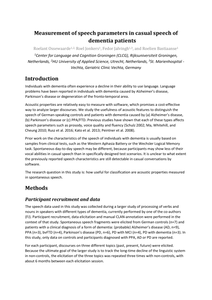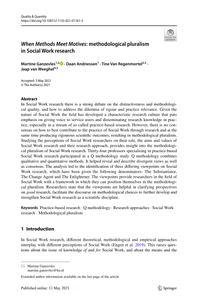The aim of this study is to assess information on voice quality features and to ascertain the variability of these features in specified groups. Groups were created based on gender and status of vocal training, in order to study the influence of these grouping variables on selected voice quality features. Gender was chosen as a grouping variable, because previous investigations clearly demonstrated differences in voice quality characteristics between men and women. These differences have implications for the creation of a normative database, concerning its proposed function as a frame of reference. Vocal training was intentionally introduced to give direction to what might be regarded as good vocal characteristics, as compared to characteristics of subjects without vocal training. Characteristics of the vocal apparatus and voice quality features can be acquired in many ways. Four practicable methods, easily employed in a clinical environment and extensively outlining the vocal apparatus and voice function, are used in this study. Results of these investigations are described in the following chapters.
DOCUMENT
Among other things, learning to write entails learning how to use complex sentences effectively in discourse. Some research has therefore focused on relating measures of syntactic complexity to text quality. Apart from the fact that the existing research on this topic appears inconclusive, most of it has been conducted in English L1 contexts. This is potentially problematic, since relevant syntactic indices may not be the same across languages. The current study is the first to explore which syntactic features predict text quality in Dutch secondary school students’ argumentative writing. In order to do so, the quality of 125 argumentative essays written by students was rated and the syntactic features of the texts were analyzed. A multilevel regression analysis was then used to investigate which features contribute to text quality. The resulting model (explaining 14.5% of the variance in text quality) shows that the relative number of finite clauses and the ratio between the number of relative clauses and the number of finite clauses positively predict text quality. Discrepancies between our findings and those of previous studies indicate that the relations between syntactic features and text quality may vary based on factors such as language and genre. Additional (cross-linguistic) research is needed to gain a more complete understanding of the relationships between syntactic constructions and text quality and the potential moderating role of language and genre.
DOCUMENT

Assistive technology supports maintenance or improvement of an individual’s functioning and independence, though for people in need the access to assistive products is not always guaranteed. This paper presents a generic quality framework for assistive technology service delivery that can be used independent of the setting, context, legislative framework, or type of technology. Based on available literature and a series of discussions among the authors, a framework was developed. It consists of 7 general quality criteria and four indicators for each of these criteria. The criteria are: accessibility; competence; coordination; efficiency; flexibility; user centeredness, and infrastructure. This framework can be used at a micro level (processes around individual users), meso level (the service delivery scheme or programme) or at a macro level (the whole country). It aims to help identify in an easy way the main strengths and weaknesses of a system or process, and thus guide possible improvements. As a next step in the development of this quality framework the authors propose to organise a global consultancy process to obtain responses from stakeholders across the world and to plan a number of case studies in which the framework is applied to different service delivery systems and processes in different countries.
DOCUMENT

Quality of life serves a reference against which you can measure the various domains of your own life or that of other individuals, and that can change over time. This definition of the World Health Organization encompasses many elements of daily living, including features of the individual and the environment around us, which can either be the social environment, the built environment, or other environmental aspects. This is one of the rationales for the special issue on “Quality of Life: The Interplay between Human Behaviour, Technology and the Environment”. This special issue is a joint project by the Centre of Expertise Health Innovation of the Hague University of Applied Sciences in The Netherlands. The main focus of this Special Issue is how optimising the interplay between people, the environment, and technology can enhance people’s quality of life. The focus of the contributions in this special issue is on the person or end‐user and his or her environment, both the physical, social, and digital environment, and on the interaction between (1) people, (2) health, care, and systems, and (3) technology. Recent advances in technology offer a wide range of solutions that support a healthy lifestyle, good quality of life, and effective and efficient healthcare processes, for a large number of end‐users, both patients/clients from minus 9 months until 100+ years of age, as well as practitioners/physicians. The design of new services and products is at the roots of serving the quality of life of people. Original article at MDPI; DOI: https://doi.org/10.3390/ijerph16245106 (Editorial of Special Issue with the same title: "Quality of Life: The Interplay between Human Behaviour, Technology and the Environment")
MULTIFILE

From the article: "Individuals with dementia often experience a decline in their ability to use language. Language problems have been reported in individuals with dementia caused by Alzheimer’s disease, Parkinson’s disease or degeneration of the fronto-temporal area. Acoustic properties are relatively easy to measure with software, which promises a cost-effective way to analyze larger discourses. We study the usefulness of acoustic features to distinguish the speech of German-speaking controls and patients with dementia caused by (a) Alzheimer’s disease, (b) Parkinson’s disease or (c) PPA/FTD. Previous studies have shown that each of these types affects speech parameters such as prosody, voice quality and fluency (Schulz 2002; Ma, Whitehill, and Cheung 2010; Rusz et al. 2016; Kato et al. 2013; Peintner et al. 2008). Prior work on the characteristics of the speech of individuals with dementia is usually based on samples from clinical tests, such as the Western Aphasia Battery or the Wechsler Logical Memory task. Spontaneous day-to-day speech may be different, because participants may show less of their vocal abilities in casual speech than in specifically designed test scenarios. It is unclear to what extent the previously reported speech characteristics are still detectable in casual conversations by software. The research question in this study is: how useful for classification are acoustic properties measured in spontaneous speech."
MULTIFILE

Purpose: This is a position paper describing the elements of an international framework for assistive techhnology provision that could guide the development of policies, systems and service delivery procedures across the world. It describes general requirements, quality criteria and possible approaches that may help to enhance the accessibility of affordable and high quality assistive technology solutions. Materials and methods: The paper is based on the experience of the authors, an analysis of the existing literature and the inputs from many colleagues in the field of assistive technology provision. It includes the results of discussions of an earlier version of the paper during an international conference on the topic in August 2017. Results and conclusion: The paper ends with the recommendation to develop an international standard for assistive technology provision. Such a standard can have a major impact on the accessibility of AT for people with disabilities. The paper outlines some the key elements to be included in a standard.
DOCUMENT

Analysis of spontaneous speech is an important tool for clinical linguists to diagnose various types of neurodegenerative disease that affect the language processing areas. Prosody, fluency and voice quality may be affected in individuals with Parkinson's disease (PD, degradation of voice quality, unstable pitch), Alzheimer's disease (AD, monotonic pitch), and the non-fluent type of Primary Progressive Aphasia (PPA-NF, hesitant, non-fluent speech). In this study, the performance of a SVM classifier is evaluated that is trained on acoustic features only. The goal is to distinguish different types of brain damage based on recorded speech. Results show that the classifier can distinguish some dementia types (PPA-NF, AD), but not others (PD).
DOCUMENT
This research paper looks at a selection of science-fiction films and its connection with the progression of the use of television, telephone and print media. It also analyzes statistical data obtained from a questionnaire conducted by the research group regarding the use of communication media.
DOCUMENT
![Does Science-Fiction predict [or change] the future?](https://publinova-harvester-content-prod.s3.amazonaws.com/thumbnails/files/previews/pdf/20250506145555255024.adbf7edd-9619-4d0e-9a17-e0e7096adc7f-thumbnail-400x300.png)
In Social Work research there is a strong debate on the distinctiveness and methodological quality, and how to address the dilemma of rigour and practice relevance. Given the nature of Social Work the field has developed a characteristic research culture that puts emphasis on giving voice to service users and disseminating research knowledge in practice, especially in a stream of so called practice-based research. However, there is no consensus on how to best contribute to the practice of Social Work through research and at the same time producing rigourous scientific outcomes, resulting in methodological pluralism. Studying the perceptions of Social Work researchers on their role, the aims and values of Social Work research and their research approach, provides insight into the methodological pluralism of Social Work research. Thirty-four professors specialising in practice-based Social Work research participated in a Q methodology study. Q methodology combines qualitative and quantitative methods. It helped reveal and describe divergent views as well as consensus. The analysis led to the identification of three differing viewpoints on Social Work research, which have been given the following denominators: The Substantiator, The Change Agent and The Enlightener. The viewpoints provide researchers in the field of Social Work with a framework in which they can position themselves in the methodological pluralism. Researchers state that the viewpoints are helpful in clarifying perspectives on good research, facilitate the discourse on methodological choices to further develop and strengthen Social Work research as a scientific discipline
DOCUMENT

Purpose – Against the background of current leadership theory, this research paper analyses and compares the leadership approaches of two outstanding leaders: Daniel Vasella, chairman of the leading Swiss pharmaceutical organization Novartis and Ricardo Semler, owner of the Brazilian conglomerate Semco. In contrast to many rather abstract, unpractical and pointlessly theoretical papers on leadership this analysis provides a more applied view of leadership by means of the life history approach delivering insight into both leaders’ development and leader personality. Methodology/approach – First, this paper locates the ideas and practices associated with the term “leadership” as a concept through theories that have developed over time and shows how the practices of leading can be derived and understood through chosen theories. Based on this, the specific characteristics and career paths of both leaders are presented and compared so that a final analysis of their leadership approach can be done. The paper is based on secondary sources such as peer-reviewed business journals and literature on leadership. Information about both leaders and their approach to leadership is gathered mainly from published interviews with them. Additional information on Semler is taken from his autobiography. Conclusions – It is difficult to identify an “essence” of leadership, whether that takes the form of personality characteristics or traits, charisma, the ability to transform people or organizations or a brain function. All presented theories of leadership seem to have their raison d’être. Both Vasella and Semler apply a combination of different attitudes and behaviours that characterize their leadership style containing elements of transformational, charismatic, ethical, servant and authentic leadership.
MULTIFILE
